Key takeaways
- Concert photography captures the energy and connection of live performances, demanding a blend of artistic anticipation and technical skill.
- Canon cameras are preferred for their reliable autofocus, excellent color reproduction, and durability, making them suitable for dynamic concert environments.
- Key camera settings for concert photography include using manual mode, a wide aperture, high ISO, and AI Servo autofocus to effectively freeze moments despite challenging lighting conditions.
- Enhancing concert photos involves thoughtful editing, purposeful cropping, and maintaining a consistent style to convey the live atmosphere effectively.
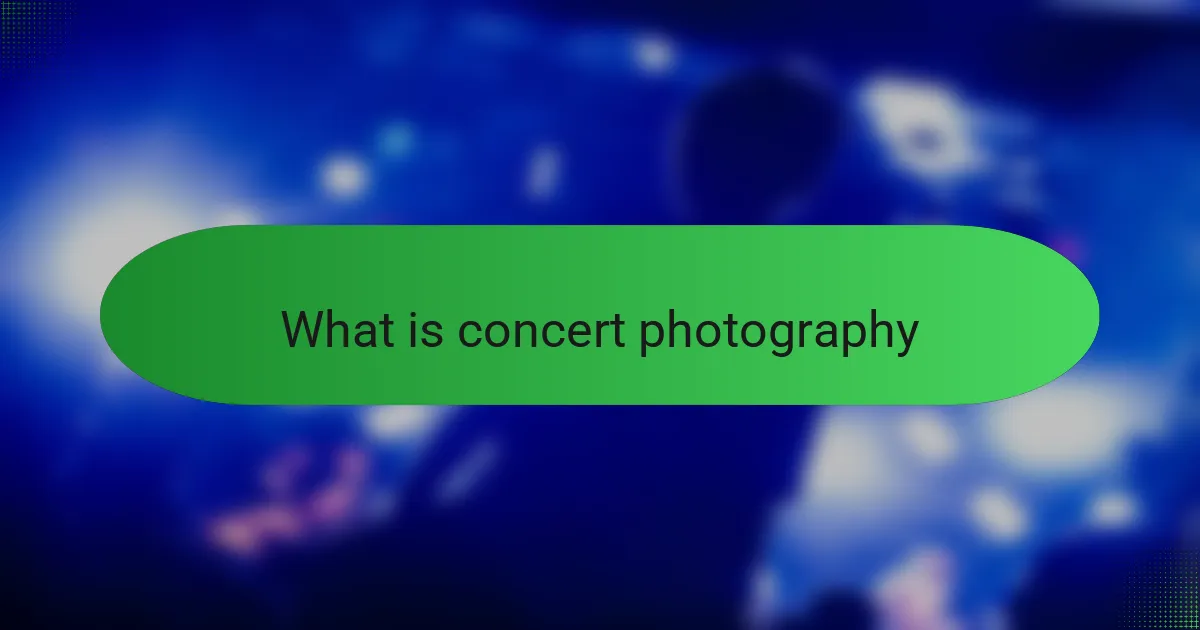
What is concert photography
Concert photography is all about capturing the raw energy and emotion of live music performances. It’s not just snapping pictures—it’s freezing moments where the music truly comes alive, like that intense gaze from the lead singer or the wild motion of a guitarist mid-riff. Have you ever felt the surge of electricity in the air at a concert? That’s the feeling I strive to bottle in every shot.
From my experience, it’s a unique blend of art and technique. You have to anticipate the perfect split second—a drumstick mid-air, a singer belting out a high note—while working in tricky lighting conditions. It’s challenging, but that challenge is what makes it so rewarding.
Ultimately, concert photography tells a story. It’s not just about the band on stage, but the atmosphere they create and the connection they build with the crowd. Capturing that story requires being both a fan and a photographer, which is exactly why I love shooting concerts with my Canon camera.
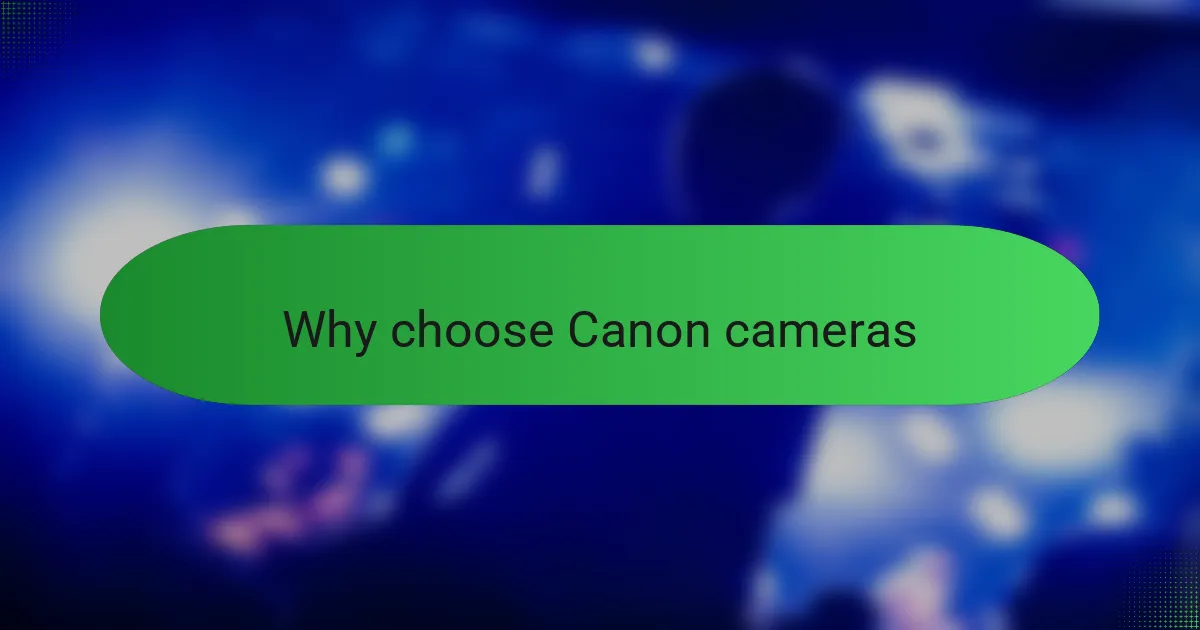
Why choose Canon cameras
When I first started photographing concerts, I quickly realized Canon cameras just get what I’m trying to do. Their autofocus is incredibly reliable, even in the chaos of stage lights and fast movements. Have you ever missed a shot because your camera couldn’t keep up? With Canon, that frustration happens far less often.
The color reproduction on Canon cameras also stands out to me. Live shows are filled with dramatic lighting schemes that can easily throw off white balance, but Canon handles these shifts gracefully. Capturing the true vibe of a concert—the reds, blues, and everything in between—feels amazingly authentic through my viewfinder.
Plus, Canon bodies are built tough, which matters when I’m jostling through crowds or navigating tight spaces near the stage. I’ve dropped mine a couple of times, and it keeps performing like a champ. That durability gives me confidence to focus on the music and moments, not on whether my gear will hold up.
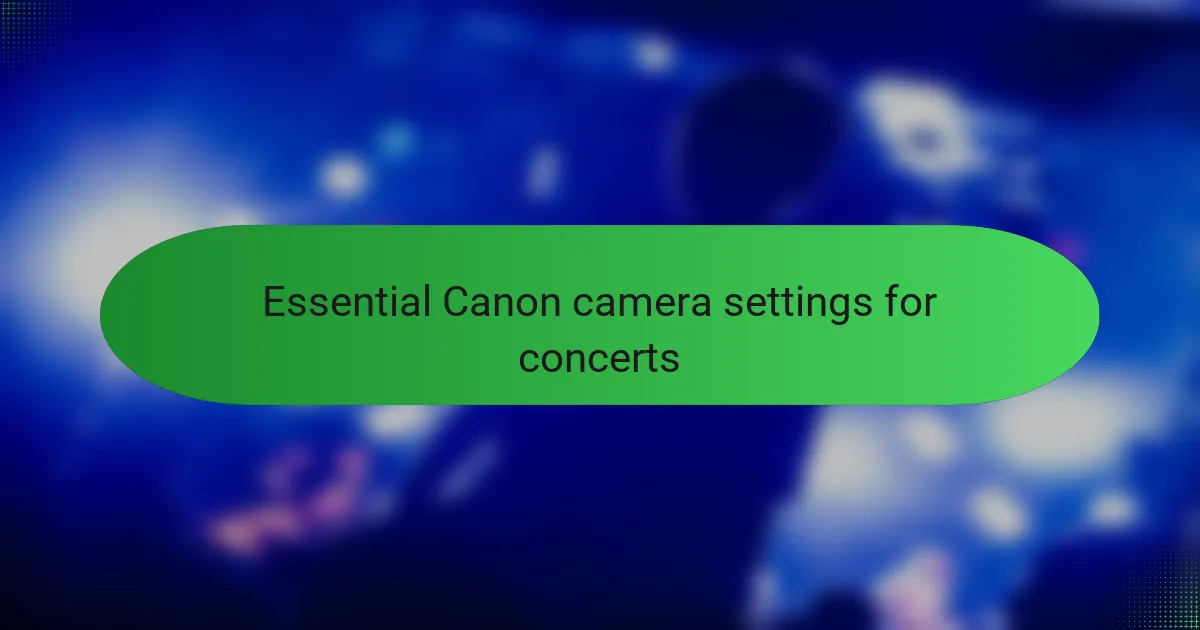
Essential Canon camera settings for concerts
Setting the right Canon camera parameters for concerts can make or break your shots. From my experience, shooting in manual mode gives me complete control over exposure, especially when the lighting is unpredictable. I usually go with a wide aperture—around f/2.8—to let in as much light as possible while keeping the focus sharp on the performers.
ISO settings? I tend to crank it up, sometimes as high as 3200 or more, depending on the venue’s darkness. Sure, noise can creep in at higher ISO, but with Canon’s noise reduction, I find the trade-off worth it to keep the energy and movement crisp. Have you ever struggled with blurry shots because your camera’s ISO was too low for the scene? That was me, until I learned to embrace higher ISO settings.
One more trick I swear by is adjusting the autofocus mode to AI Servo. It tracks moving subjects steadily, which is essential when band members are constantly on the move. I remember missing some fantastic moments before I switched from One-Shot to AI Servo—lesson learned! Trust me, this setting keeps your images sharp even amid the chaos of a wild rock show.
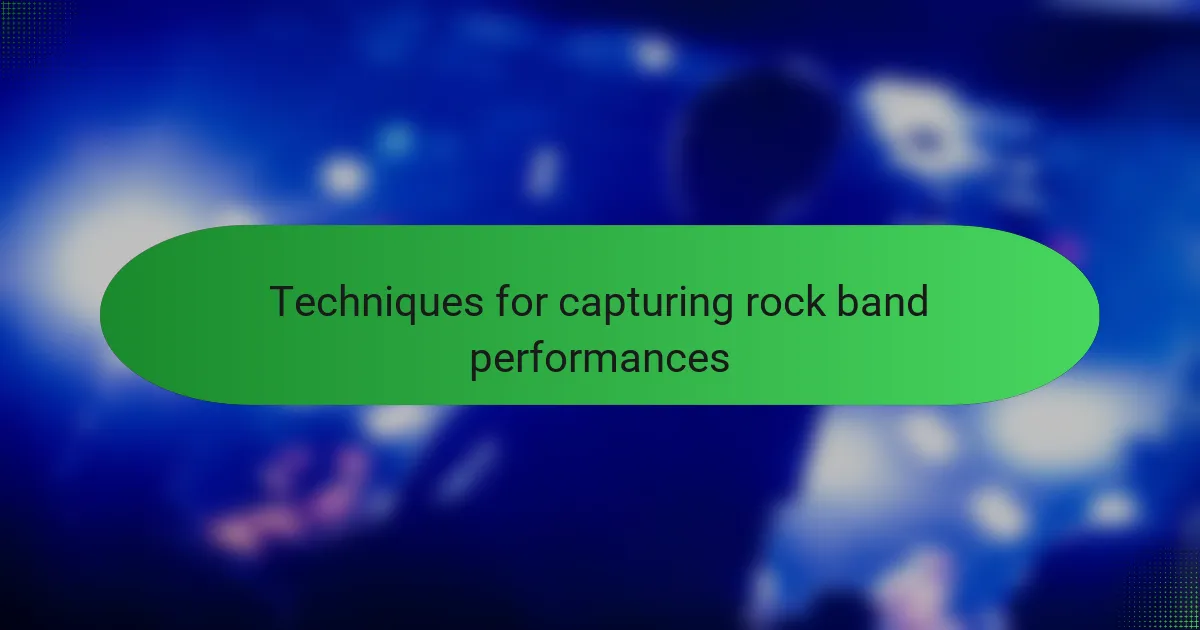
Techniques for capturing rock band performances
Capturing rock band performances is all about anticipating those explosive moments before they happen. I’ve found that locking focus early on a key band member, like the lead guitarist during a solo, helps me stay ready for the peak action—otherwise, you risk missing that jaw-dropping expression or lightning-fast hand movement.
Lighting can be brutal in concerts, bouncing between dark shadows and bright spotlights. I often switch to a faster shutter speed to freeze motion, but balancing that with enough light means pushing my Canon’s ISO higher than I’d like. Have you ever wrestled with blurry photos despite your best efforts? That’s why mastering shutter speed and ISO together is crucial.
One technique I swear by is framing for storytelling, not just individual shots. Capturing the interaction between band members or the crowd’s reaction gives depth to the performance. I remember nailing a shot where the drummer’s wild energy reflected perfectly in the lead singer’s mirror sunglasses—moments like that make all the technical challenges worth it.
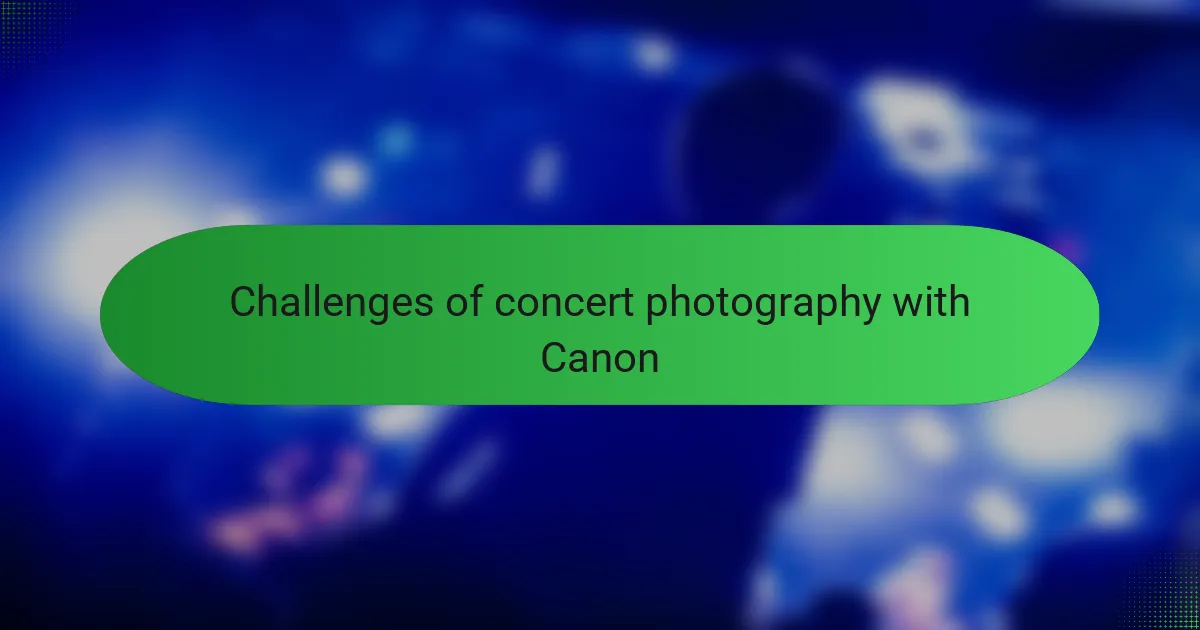
Challenges of concert photography with Canon
Concert photography with Canon isn’t without its hurdles. For instance, even though Canon cameras handle low light well, I’ve often struggled capturing fast-moving performers without motion blur, especially during high-energy songs where every second counts. Have you ever tried freezing a cloud of flying hair or a guitarist’s rapid fretwork only to find your shutter speed just couldn’t keep up?
Another challenge I’ve faced is managing the ever-shifting stage lighting. Canon’s auto white balance does a decent job, but those wild color changes—like a sudden burst of red or blue—can confuse the sensor, leaving me scrambling to adjust settings mid-show. It’s a constant race between adapting and missing a priceless moment.
Lastly, while Canon bodies feel durable, I’ve found the weight can become taxing during long concerts. Holding the camera steady for multiple hours with heavy lenses onboard sometimes makes my arms ache, which ironically affects my shot stability. Ever noticed how physical fatigue can sneak up on you during a long gig? That’s an unexpected challenge no camera manual warns you about.
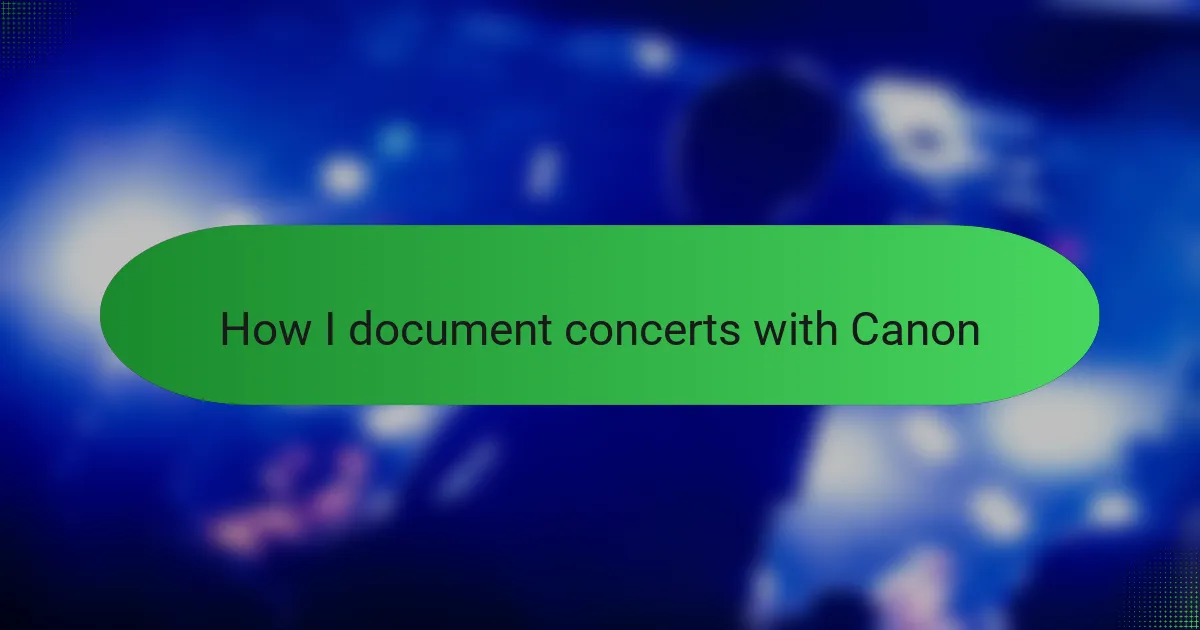
How I document concerts with Canon
Documenting concerts with my Canon camera is an experience that blends spontaneity with a bit of strategy. I usually start by adjusting my settings quickly as the show kicks off, trusting Canon’s autofocus to catch those electrifying moments—like the lead singer’s intense stare or the drummer’s cascade of energy. Have you ever tried capturing a split second when the crowd is roaring and the stage lights are flashing? That’s when I rely on Canon to make my shot.
One thing I’ve learned is to stay mobile and adapt fast. Concerts are unpredictable, so I keep my camera close, switching between lenses depending on the distance and mood. Sometimes, I find myself sneaking through the crowd or crouching near the stage edge just to get a unique angle. It’s exhausting but thrilling, and Canon’s ergonomics really help me maintain steady shots amidst all the chaos.
After the show, reviewing the images is like reliving the concert’s energy all over again. I remember one gig where the colors seemed almost surreal through my Canon’s sensor—those reds and blues weren’t just lights; they felt alive. It reminds me why I keep documenting these moments: to capture not just the music, but the feeling pulsing through every frame. Wouldn’t you agree that photos should make you feel the music, not just see it?
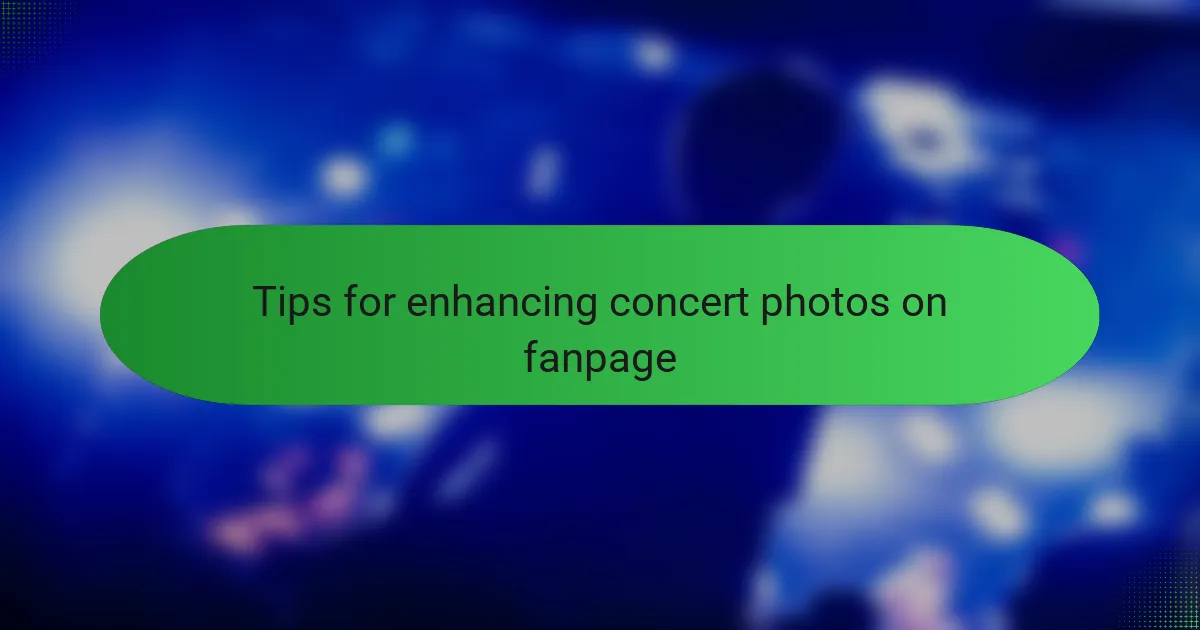
Tips for enhancing concert photos on fanpage
Enhancing concert photos on your fanpage starts with thoughtful editing that preserves the raw energy you captured. I usually boost contrast and clarity just enough to make the details pop without losing that gritty, live feel. Have you noticed how a slight tweak in shadows can bring out the sweat and intensity in a guitarist’s expression? That little adjustment pulls viewers closer to the moment.
Another tip I swear by is cropping with purpose. Instead of squeezing the entire stage into the frame, I focus on storytelling—like cutting in tight on the lead singer’s face or a fist raised in the crowd. It’s surprising how a well-cropped image can transform a chaotic scene into a powerful narrative. When I do this, the photo not only looks cleaner but also communicates the vibe of the night more clearly.
Finally, don’t underestimate the power of consistency across your photos. Using a similar editing style or preset helps your fanpage feel like a cohesive album rather than a random collection of snapshots. I learned this the hard way when my first gallery looked disjointed, and fans didn’t get that unifying concert atmosphere. Now, keeping a consistent color tone and mood makes each image feel like a piece of a larger story.